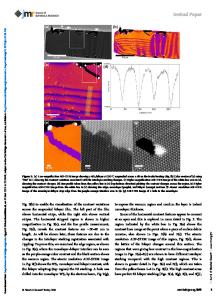Manufacturing strategies for wafer-scale two-dimensional transition metal dichalcogenide heterolayers
- PDF / 1,663,154 Bytes
- 19 Pages / 584.957 x 782.986 pts Page_size
- 103 Downloads / 883 Views
Manufacturing strategies for wafer-scale two-dimensional transition metal dichalcogenide heterolayers Mengjing Wang1, Hao Li2, Tae-Jun Ko1, Mashiyat Sumaiya Shawkat3, Emmanuel Okogbue3, Changhyeon Yoo1, Sang Sub Han4, Md Ashraful Islam3, Kyu Hwan Oh5, Yeonwoong Jung6,a) 1
NanoScience Technology Center, University of Central Florida, Orlando, Florida 32826, USA NanoScience Technology Center, University of Central Florida, Orlando, Florida 32826, USA; and Department of Materials Science and Engineering, University of Central Florida, Orlando, Florida 32826, USA 3 NanoScience Technology Center, University of Central Florida, Orlando, Florida 32826, USA; and Department of Electrical and Computer Engineering, University of Central Florida, Orlando, Florida 32816, USA 4 NanoScience Technology Center, University of Central Florida, Orlando, Florida 32826, USA; and Department of Materials Science and Engineering, Seoul National University, Seoul 08826, South Korea 5 Department of Materials Science and Engineering, Seoul National University, Seoul 08826, South Korea 6 NanoScience Technology Center, University of Central Florida, Orlando, Florida 32826, USA; Department of Materials Science and Engineering, University of Central Florida, Orlando, Florida 32826, USA; and Department of Electrical and Computer Engineering, University of Central Florida, Orlando, Florida 32816, USA a) Address all correspondence to this author. e-mail: [email protected] This paper has been selected as an Invited Feature Paper. 2
Received: 21 October 2019; accepted: 13 January 2020
Modern electronics have been geared toward exploring novel electronic materials that can encompass a broad set of unusual functionalities absent in conventional platforms. In this regard, two-dimensional (2D) transition metal dichalcogenide (TMD) semiconductors are highly promising, owing to their large mechanical resilience coupled with superior transport properties and van der Waals (vdW) attraction-enabled relaxed assembly. Moreover, 2D TMD heterolayers based on chemically distinct constituent layers exhibit even more intriguing properties beyond their mono-component counterparts, which can materialize only when they are manufactured on a technologically practical wafer-scale. This mini-review provides a comprehensive overview of recent progress in exploring wafer-scale 2D TMD heterolayers of various kinds. It extensively surveys a variety of manufacturing strategies and discusses their scientific working principles, resulting 2D TMD heterolayers, their material properties, and device applications. Moreover, it offers extended discussion on remaining challenges and future outlooks toward further improving the material quality of 2D TMD heterolayers in both material and manufacturing aspects.
Introduction The development of low-dimensional nanomaterials (e.g., carbon nanotubes, one-dimensional (1D) nanowires, and two-dimensional (2D) layered materials) presents tremendous opportunities in the enrichment of life quality by bringing forth previously conceptually
Data Loading...











